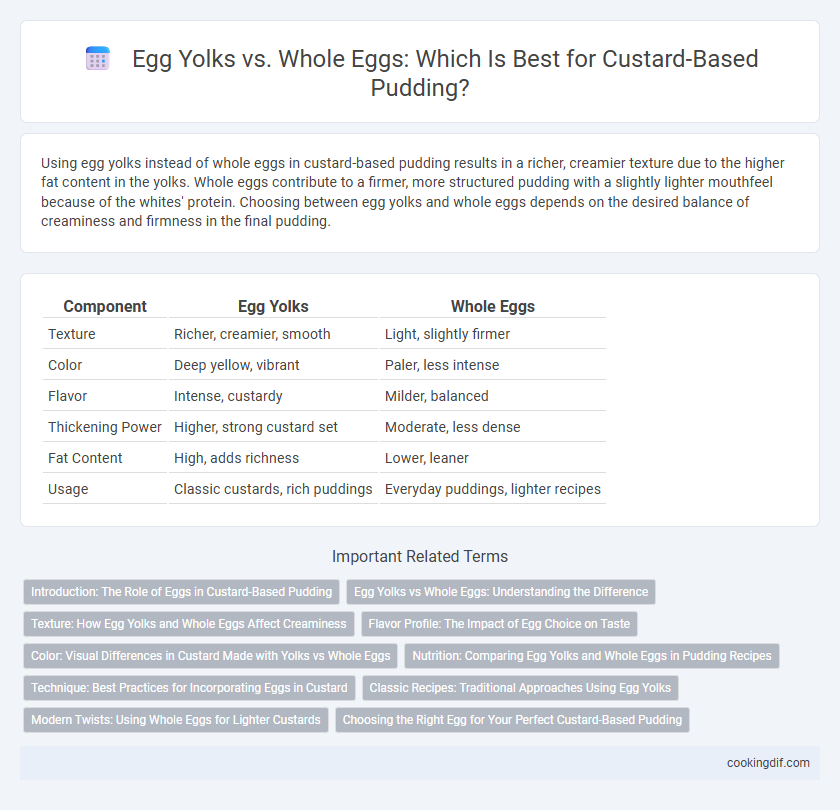Using egg yolks instead of whole eggs in custard-based pudding results in a richer, creamier texture due to the higher fat content in the yolks. Whole eggs contribute to a firmer, more structured pudding with a slightly lighter mouthfeel because of the whites' protein. Choosing between egg yolks and whole eggs depends on the desired balance of creaminess and firmness in the final pudding.
Table of Comparison
| Component | Egg Yolks | Whole Eggs |
|---|---|---|
| Texture | Richer, creamier, smooth | Light, slightly firmer |
| Color | Deep yellow, vibrant | Paler, less intense |
| Flavor | Intense, custardy | Milder, balanced |
| Thickening Power | Higher, strong custard set | Moderate, less dense |
| Fat Content | High, adds richness | Lower, leaner |
| Usage | Classic custards, rich puddings | Everyday puddings, lighter recipes |
Introduction: The Role of Eggs in Custard-Based Pudding
Egg yolks provide rich creaminess and a velvety texture crucial for custard-based pudding, as their high fat content enhances smoothness and flavor depth. Whole eggs contribute structure and firmness due to their protein content, resulting in a firmer, less creamy pudding texture. Balancing yolks and whole eggs influences the pudding's consistency, richness, and overall mouthfeel, making egg selection essential in recipe formulation.
Egg Yolks vs Whole Eggs: Understanding the Difference
Egg yolks create a richer, creamier texture in custard-based pudding by contributing high fat content and emulsifying properties that enhance smoothness and thickness. Whole eggs, containing both yolk and white, result in a lighter texture with more structure due to the protein in egg whites, but may produce a firmer, less silky custard. Understanding the balance between yolk and whole egg usage allows precise control over pudding consistency, creaminess, and flavor depth.
Texture: How Egg Yolks and Whole Eggs Affect Creaminess
Egg yolks contribute a rich, velvety texture to custard-based pudding, creating a creamier and silkier mouthfeel due to their high fat and lecithin content. Whole eggs provide more structure and firmness in the pudding, resulting in a slightly denser and less smooth texture. Using primarily egg yolks enhances the custard's smoothness, while whole eggs balance creaminess with stability.
Flavor Profile: The Impact of Egg Choice on Taste
Egg yolks contribute a rich, creamy texture and a distinct, velvety flavor to custard-based pudding, enhancing its overall depth and sweetness. Using whole eggs results in a lighter consistency with a more neutral taste, allowing other ingredients to shine without overpowering richness. The choice between egg yolks and whole eggs significantly affects the pudding's flavor profile, balancing intensity and smoothness in the final dish.
Color: Visual Differences in Custard Made with Yolks vs Whole Eggs
Custard-based pudding made with egg yolks exhibits a richer, deeper yellow color compared to the paler, creamier hue of pudding made with whole eggs. The higher concentration of carotenoids in egg yolks intensifies the golden tone, enhancing visual appeal. Whole eggs introduce more white albumen, which dilutes pigmentation and results in a lighter, less vibrant custard color.
Nutrition: Comparing Egg Yolks and Whole Eggs in Pudding Recipes
Egg yolks are rich in vitamins A, D, E, and K, along with higher concentrations of healthy fats and cholesterol, which contribute to the creamy texture of custard-based puddings. Whole eggs provide a balanced source of protein, essential amino acids, and additional nutrients from the egg whites, such as riboflavin and selenium, supporting overall nutrition. Choosing egg yolks enhances richness and creaminess, while whole eggs offer a more balanced nutrient profile with lower fat content per serving.
Technique: Best Practices for Incorporating Eggs in Custard
Using egg yolks alone in custard-based pudding yields a richer, creamier texture due to their higher fat content and emulsifying properties. Whole eggs provide a firmer set and slightly lighter texture because the whites contribute structure through coagulation. For best results, temper eggs carefully by slowly blending hot milk into the egg mixture to prevent curdling and achieve a smooth, velvety pudding consistency.
Classic Recipes: Traditional Approaches Using Egg Yolks
Classic custard-based pudding recipes rely heavily on egg yolks due to their rich fat content and emulsifying properties, which create a smooth, creamy texture and deep yellow hue. Whole eggs can be used but tend to produce a firmer, less velvety consistency because the whites add protein that tightens the custard structure. Traditional French creme brulee and vanilla pudding often specify only yolks to achieve the signature luxurious mouthfeel and delicate flavor balance.
Modern Twists: Using Whole Eggs for Lighter Custards
Using whole eggs in custard-based pudding creates a lighter, creamier texture compared to the traditional richness of egg yolks alone. Whole eggs contribute to a balanced custard with increased volume and a smoother mouthfeel, appealing to modern palates seeking less dense desserts. This approach also simplifies preparation and reduces fat content while maintaining the essential custard flavor profile.
Choosing the Right Egg for Your Perfect Custard-Based Pudding
Egg yolks contribute to a rich, creamy texture and a golden color in custard-based pudding, providing a smooth, velvety mouthfeel that whole eggs cannot replicate. Whole eggs add structure and stability but may result in a firmer, less tender pudding, affecting the delicate balance of flavors. Selecting the right egg depends on whether a silky, luscious consistency (egg yolks) or a more set, puffed texture (whole eggs) is desired for the final pudding.
Egg yolks vs whole eggs for custard-based pudding Infographic

 cookingdif.com
cookingdif.com